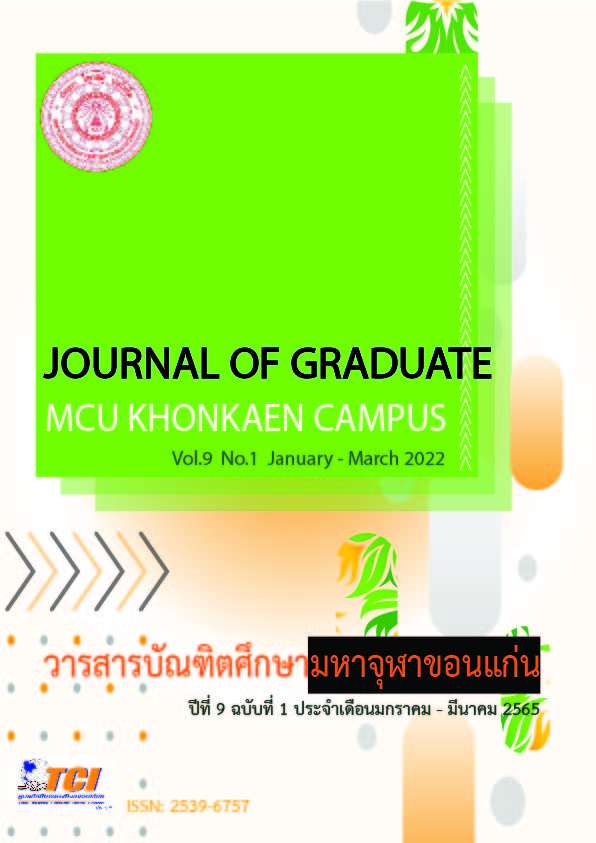The Meditation and Recociliation in Terms of Buddhism : A Case Study of Public Prosecutors of Department of Civil Rights Protection and Legal Aid, Nong Khai Province
Main Article Content
Abstract
This research article The objectives were 1) to study the condition of problems and obstacles of public prosecutors; 2) to analyze the principles of mediation and conciliation in criminal cases in Thai law of public prosecutors; 3) to propose guidelines for applying mediation and conciliation in Buddhism. To protect rights and help people in law and execution Nong Khai Province Qualitative research was used by collecting data from 195 case studies between 2017 and 2021 and key information was provided by judges, public prosecutors, conciliators, investigative staff, lawyers, people who received rights protection. and helping the people in the law and legal execution of Nong Khai Province, amounting to 45 people
The results showed that Problems and obstacles of the public prosecutor There are problems with the powers and duties of the Attorney General in reconciling criminal disputes. Settlement of mediation and conciliation The extent to which a criminal offense can enter the mediation process at the investigative stage Criminal cases are settled before being filed before the court or pending the adjudication of the court. Civil liability in connection with a criminal case in the enforcement of the prosecutor's compromise agreement The time limit stops in criminal prosecution of the victim or the prosecutor in cases where the prosecutor has successfully mediated and conciliated a criminal dispute and the parties enter into a conciliation agreement. The prosecutor has successfully applied the principles of mediation and conciliation in criminal cases in Thai law, namely the attitude, ability and experience, knowledge, expertise in the use of law, experience and qualifications of the public prosecutor. along with the principles of physical strength, the 5 Brahma Viharas, the 4 Prejudices, the 4 Noble Truths and the principle of yonisomanasikan thinking come as a guideline for solving problems and eliminating obstacles to mediation Make effective mediation negotiations.
Article Details

This work is licensed under a Creative Commons Attribution-NonCommercial-NoDerivatives 4.0 International License.
References
กษิรา เทียนส่องใจ. (2550). การศึกษาวิเคราะห์อภัยทาน เพื่อการจัดการความขัดแย้งในสังคมไทยปัจจุบัน. (วิทยานิพน์พุทธศาสตรมหาบัณฑิต). พระนครศรีอยุธยา: มหาวิทยาลัยมหาจุฬาลงกรณราชวิทยาลัย.
จักรกริญน์ ทอดสูงเนิน. (2557). ปัจจัยที่มีผลต่อความสำเร็จของการไกล่เกลี่ยข้อพิพาทในชุมชนกรณีศึกษาศูนย์ยุติธรรมชุมชนตำบลโคกขาม อำเภอเมือง จังหวัดสมุทรสาคร. วารสารสังคมศาสตร์และมนุษยศาสตร์, 40(1), 98-113.
จำนงค์ อดิวัฒน์สิทธิ์. (2544). สังคมวิทยาตามแนวพุทธศาสตร์. กรุงเทพฯ: มหาจุฬาลงกรณราชวิทยาลัย.
ชลากร เทียนส่องใจ. (2554). การเจรจาไกล่เกลี่ยคนกลางเชิงพุทธ : หลักการและเครื่องมือสำหรับการจัดการความขัดแย้ง. (วิทยานิพนธ์พุทธศาสตรดุษฎีบัณฑิต). พระนครศรีอยุธยา: มหาวิทยาลัยมหาจุฬาลงกรณราชวิทยาลัย.
ดำริห์ สุตเตมีย์. (2539). การไกล่เกลี่ยข้อพิพาทโดยองค์กรฝายบริหารศึกษาเฉพาะกรณีการไกล่เกลี่ยประนอมข้อพิพาทของสำนักงานคุ้มครองสิทธิและช่วยเหลือทางกฎหมายแก่ประขาชนสำนักงานอัยการสูงสุด. กรุงเทพฯ: วิทยาลัยการยุติธรรม กระทรวงยุติธรรม.
ธนทร ผดุงธิติฐ์. (2562). มาตรการทางกฎหมายเกี่ยวกับการไกล่เกลี่ยข้อพิพาททางแพ่งก่อนฟ้องคดี. วารสารมหาจุฬานาครทรรศน์, 6(10), 5824-5825.
พระธรรมปิฎก (ป.อ.ปยุตฺโต). (2546). สลายความขัดแย้ง. กรุงเทพฯ: สหธรรมิก.
พระมหาหรรษา ธมฺมหาโส (นิธิบุณยากร). (2547). รูปแบบการจัดการความขัดแย้งโดยพุทธสันติวิธี : ศึกษาวิเคราะห์กรณีลุ่มน้ำแม่ตาช้าง จังหวัดเชียงใหม่. (วิทยานิพนธ์พุทธศาสตรดุษฎีบัณฑิต). พระนครศรีอยุธยา: มหาวิทยาลัยมหาจุฬาลงกรณราชวิทยาลัย.
พระมหาหรรษา ธมฺมหาโส. (2554). พุทธสันติวิธี : การบูรณาการหลักการและเครื่องมือจัดการความขัดแย้ง. กรุงเทพฯ: 21 เซ็นจูรี่.
มหาวิทยาลัยมหาจุฬาลงกรณราชวิทยาลัย. (2539). พระไตรปิฎกฉบับภาษาไทย มหาจุฬาลงกรณราชวิทยาลัย. พระนครศรีอยุธยา: มหาวิทยาลัยมหาจุฬาลงกรณราชวิทยาลัย.
วนิชชา โพธิ์ทอง. (2561). ผลของการประนอมข้อพิพาทในชั้นพนักงานอัยการ : กรณีศึกษาสำนักงานอัยการคุ้มครองสิทธิและช่วยเหลือทางกฎหมายและการบังคับคดีในสังกัดภาค 2. วารสารการเมืองการปกครอง, 8(3), 152-168.
สถาบันวิจัยและพัฒนา มหาวิทยาลัยรามคำแหง. (2550). การประเมินผลโครงการนาร่องเพื่อเสริมสร้างกระบวนการปฏิบัติงานและเพิ่มศักยภาพอาสาสมัครไกล่เกลี่ยข้อพิพาทในชุมชน (อ.ก.ช.). กรุงเทพฯ: มหาวิทยาลัยรามคำแหง.
สถาบันวิจัยและพัฒนามหาวิทยาลัยรามคำแหง. (2550). การประเมินผลโครงการนาร่องเพื่อเสริมสร้างกระบวนการปฏิบัติงานและเพิ่มศักยภาพอาสาสมัครไกล่เกลี่ยข้อพิพาทในชุมชน (อ.ก.ช.). (รายงานการวิจัย). สถาบันวิจัยและพัฒนามหาวิทยาลัยรามคำแหง.
สมเกียรติ แพทย์คุณ. (2548). การพัฒนารูปแบบการประนอมข้อพิพาทในชั้นการดำเนินการของพนักงานอัยการ. (วิทยานิพนธ์ศิลปศาสตรดุษฎีบัณฑิต). ขอนแก่น: มหาวิทยาลัยขอนแก่น.
สำนักงานอัยการสูงสุด. (2559). คู่มือการช่วยเหลือในการประนอมข้อพิพาทแก่ประชาชน. กรุงเทพฯ: สำนักงานอัยการสูงสุด.
สำนักงานอัยการสูงสุด. (2559). รวมกฎหมาย ระเบียบ คำสั่ง ประกาศ และหนังสือเวียนปฏิบัติที่เกี่ยวข้องกับการปฏิบัติงาน สคช. กรุงเทพฯ: สำนักงานอัยการสูงสุด.
สำนักระงับข้อพิพาท สำนักงานศาลยุติธรรม. (2547). การปฏิบัติงานของอาสาสมัครไกล่เกลี่ยข้อพิพาทในชุมชน (อ.ก.ช.) : ปัญหา อุปสรรค และแนวทางแก้ไข. (รายงานการวิจัย). สำนักระงับข้อพิพาทสำนักงานศาลยุติธรรม.
สุรชัย เลี้ยงบุญเลิศชัย. (2547). แนวคิดการไกล่เกลี่ยข้อพิพาท. กรุงเทพฯ: ม.ป.ท.

